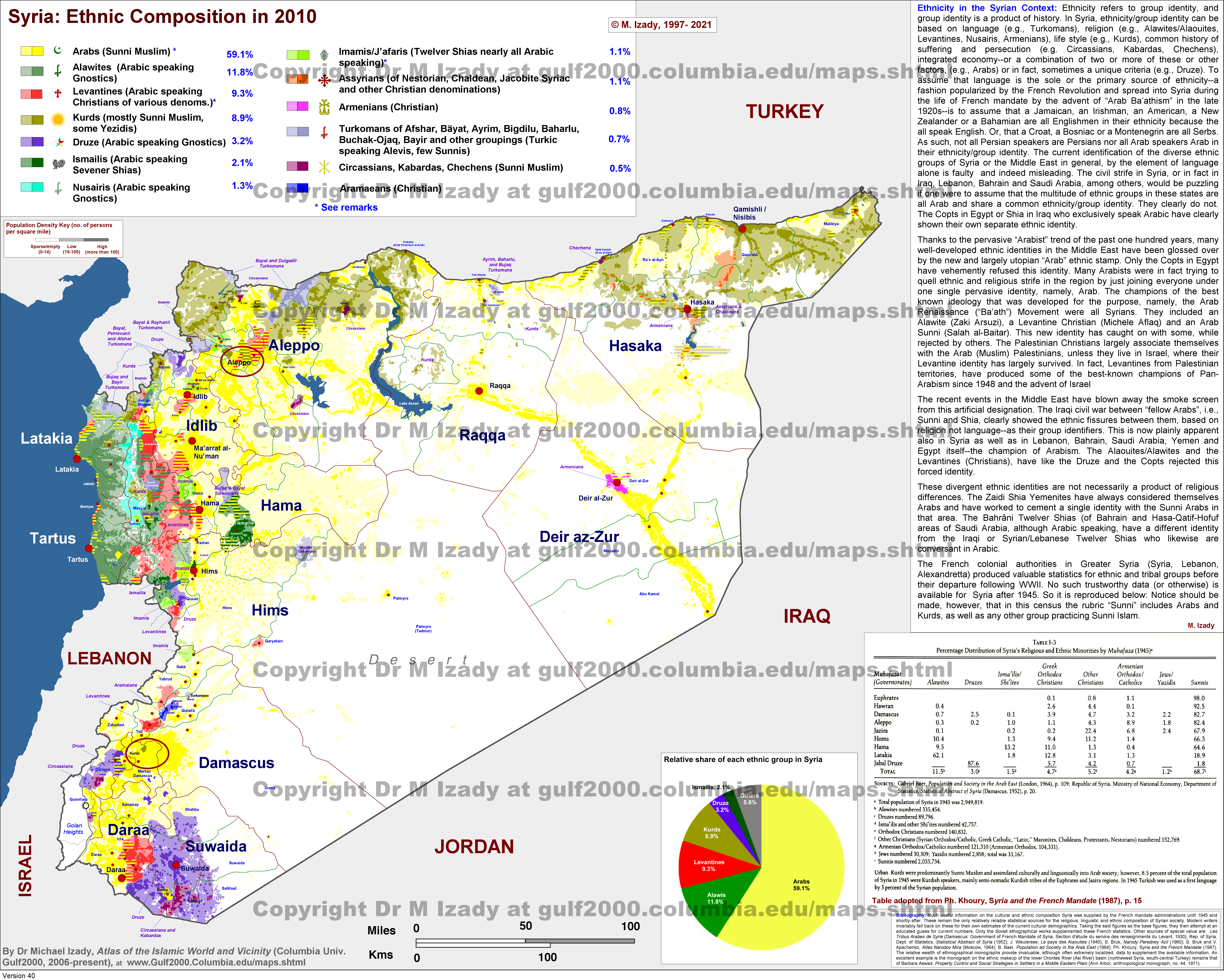Here is his blog: http://gulf2000.columbia.edu/maps.shtml .
They seem pretty detailed and accurate but there some odd choices in terms of classification of some groups.

For example, in here he separates the the alawites from the nusayris, dispate the later only being a slur for the formers.
Also he has a pet theory that lumps together a lot of heterodox (some of them Shia) sects and groups (some of them Kurdish and others not even that) into a single pre islamic "native" Kurdish religion: https://en.wikipedia.org/wiki/Yazdânism .
They seem pretty detailed and accurate but there some odd choices in terms of classification of some groups.

For example, in here he separates the the alawites from the nusayris, dispate the later only being a slur for the formers.
And there is no explanation of why he separates the two terms in different groups in the text.In older sources, Alawis are often called "Ansaris". According to Samuel Lyde, who lived among the Alawites during the mid-19th century, this was a term they used among themselves. Other sources indicate that "Ansari" is simply a Western error in the transliteration of "Nusayri".[18][19] However, the term "Nusayri" had fallen out of currency by the 1920s, as a movement led by intellectuals within the community during the French Mandate sought to replace it with the modern term "Alawi".
They characterised the older name (which implied "a separate ethnic and religious identity") as an "invention of the sect's enemies", ostensibly favouring an emphasis on "connection with mainstream Islam"—particularly the Shia branch.[20] As such, "Nusayri" is now generally regarded as antiquated, and has even come to have insulting and abusive connotations. The term is frequently employed as hate speech by Sunni fundamentalists fighting against Bashar al-Assad's government in the Syrian civil war, who use its emphasis on Ibn Nusayr in order to insinuate that Alawi beliefs are "man-made" and not divinely inspired.[21]
Recent research has shown that the Alawi appellation was used by the sect's adherents since the 11th century. The following quote from Alkan (2012) illustrates this point:
"In actual fact, the name 'Alawī' appears as early as in an 11th century Nuṣayrī tract (…). Moreover, the term 'Alawī' was already used at the beginning of the 20th century. In 1903 the Belgian-born Jesuit and Orientalist Henri Lammens (d. 1937) visited a certain Ḥaydarī-Nuṣayrī sheikh Abdullah in a village near Antakya and mentions that the latter preferred the name 'Alawī' for his people. Lastly, it is interesting to note that in the above-mentioned petitions of 1892 and 1909 the Nuṣayrīs called themselves the 'Arab Alawī people' (ʿArab ʿAlevī ṭāʾifesi) 'our ʿAlawī Nuṣayrī people' (ṭāʾifatunā al-Nuṣayriyya al-ʿAlawiyya) or 'signed with Alawī people' (ʿAlevī ṭāʾifesi imżāsıyla). This early self-designation is, in my opinion, of triple importance. Firstly, it shows that the word 'Alawī' was always used by these people, as ʿAlawī authors emphasize; secondly, it hints at the reformation of the Nuṣayrīs, launched by some of their sheikhs in the 19th century and their attempt to be accepted as part of Islam; and thirdly, it challenges the claims that the change of the identity and name from 'Nuṣayrī' to 'ʿAlawī' took place around 1920, in the beginning of the French mandate in Syria (1919–1938)."
Also he has a pet theory that lumps together a lot of heterodox (some of them Shia) sects and groups (some of them Kurdish and others not even that) into a single pre islamic "native" Kurdish religion: https://en.wikipedia.org/wiki/Yazdânism .
His theory seems to be kinda fringe but is part of the way he structures maps that involve Kurds. I don't mind biases, everyone has one and is better that he is open with them, but the lack of explanation bothers me.The concept of Yazdânism as a distinct religion has been disputed by a number of scholars. Richard Foltz considers Yazdânism, or the “Cult of Angels”, as Izady’s “invented religion”, which according to Foltz “owes more to contemporary Kurdish national sentiment than to actual religious history.”[1]
Iranian anthropologist Ziba Mir-Hosseini states:[28]
The most notable case is that of Izady (1992) who, in his eagerness to distance the Ahl-e Haqq from Islam and to give it a purely Kurdish pedigree, asserts that the sect is a denomination of a religion of great antiquity which he calls “the Cult of Angels”. This 'Cult', he states, is "fundamentally a non-Semitic religion, with an Aryan superstructure overlaying a religious foundation indigenous to the Zagros. To identify the Cult or any of its denominations as Islamic is simply a mistake born of a lack of knowledge of the religion, which pre-dates Islam by millennia."